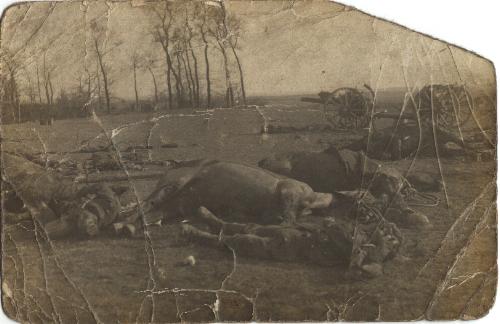26 August 1914
HMAS PIONEER, (3rd class cruiser), captured the German merchant vessel THURINGEN, off Fremantle, WA.
For long hours during the morning of 26 August, the British force at Le Ceteau, notably the field artillery, held overwhelming numbers of the enemy at bay and inflicted severe losses. British tactics were similar to those at Mons. The infantry produced intensive and accurate rifle fire, while the field artillery fired air-bursting shrapnel rounds on the unprotected enemy. Many field guns were fired at point-blank range over open sights. Some were withdrawn just as the enemy infantry closed in. For the second time in three days, the British force engaged withdrew just in time. Miraculously, the exhausted II Corps disengaged and withdrew towards the south during the afternoon. Smith-Dorrien's decision to turn II Corps around from retreat and to stand against the German advance at Le Cateau paid off handsomely. Heavy casualties were inflicted on the Germans and another delay imposed on their Schlieffen timetable. To the east, I Corps was able to move further away from the advance parties of the Germans. However, a rift grew between Sir John French (who had initially ordered a continuation of the retreat) and Smith-Dorrien as a result of this action. It was to have serious consequences in 1915.
The total British casualties at Le Cateau amounted to 7,812 of all ranks, killed, wounded and missing.
38 field guns were lost.

The Rearguard Affair of Le Grand Fayt: an action associated with the Battle of Le Cateau :
http://www.1914-1918.net/bat2A.html
The Battle of Tannenberg commenced: The morning of the 26th opened with the First Russian Army advancing west towards Königsberg, meeting little resistance. The troops that were formerly directly in front of them had moved to the south, facing the Second Army's right flank. There was still time to close the gap between the Russian armies and thereby threaten the German movements, which by this point were being reported back to Russian headquarters. Nevertheless, on the night of the 25th, the Russian field commander sent orders for the First Army to continue directly west to Königsberg, orders that were once again intercepted by the Germans.
Due to François' delays, XVII German Corps opened the battle proper. They met the two separated divisions of VI Russian Corps near Seeburg and Bischofstein, turning them both back toward the border in disarray. The right flank of the Second Russian Army was now open. In the meantime, the Russian advance toward Tannenberg continued to be blocked by XX German Corps in front of them. Their only success were in the center, where XIII Russian Corps advanced toward Allenstein unopposed.
Douai, Noyon, Longwy and Cambrai occupied by German forces.
First Battle of Lemberg (Galicia.) begins.
Battle of Zamosc-Komarow begins.
German forces in Togoland capitulate to the Allied forces.
The British cargo ship Holmwood was captured and sunk in the Atlantic Ocean 180 nautical miles (330 km) east of Pernambuco, Brazil by SMS Dresden
The SMS Magdeburg ran aground in the Baltic Sea off Odensholm, Estonia. She was subsequently attacked by Admiral Makarov and Gromoboi (both Imperial Russian Navy) and sank with the loss of 15 lives.
The battle off Rio de Oro on 26 August 1914 began when the German raider Kaiser Wilhelm der Grosse was caught by surprise in a harbor, taking on coal from three German and Austrian colliers. Highflyer, badly outgunning the German auxiliary cruiser, first demanded surrender, but the German commander argued that the British had violated Spain's neutrality.
The British disregarded this because the Germans had already violated Spain's neutrality by taking over a week to resupply in a neutral port. So a battle began, from 15:10 to 16:45 the two ships bombarded each other, sometimes dodging the shots. Eventually, Kaiser Wilhelm der Grosse exhausted her ammunition and began to flee the battle. Now out of ammunition, running from several larger guns, the crew scuttled their ship and abandoned her to the Atlantic. The German sailors made it to shore and escaped into the Saharan Desert.
Kaiser Wilhelm der Grosse became the first passenger liner to sink during World War I. For years, the wreck of the German commerce raider was identifiable because its starboard side remained above the waterline until the ship was scrapped in 1952. One Briton was killed and six others wounded. German casualties are unknown. British sources at the time insisted the German auxiliary cruiser was sunk by
Highflyer's crew but eventually stories from the surviving German seamen began to circulate, thus ending Britain's claim. Despite whether or not the Germans scuttled their ship or whether the British sank the raider, the British were still responsible for the raider's end.
General Galliéni appointed Governor of Paris (see October 30th, 1915).
M. Messimy, French Minister for War, [Appointed June 14th, 1914.] resigns.
M. Delcassé succeeds M. Doumergue [Appointed August 3rd, 1914.] as French Foreign Minister.
A Memorial service was held at St Thomas Church, Orchard Street, Portland Square for the first two British pilots to die in the war, E.W.C. Perry and H.E. Parfitt. Their deaths on 16 August was later part of a major controversy over the attitude of the RFC to its pilots’ safety. Perry and Parfitt were among the last to take off from Amiens on 16 August. As they took off in their
BE8 (number 625), the aeroplane stalled at about 150 feet from the ground – losing speed from climbing too quickly or with too little power. The aircraft turned over on its side and fell to the ground, where it caught fire. Both men were killed. They were the first British airmen ever to die in a theatre of war; Perry was also the first British officer fatality of the war (the majority of British servicemen who died before or on 16 August died in the UK). They had a full military funeral in Amiens with flag-draped coffins escorted by soldiers and senior officers, as well as members of the RFC.